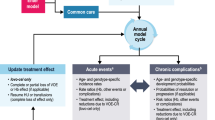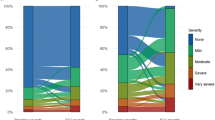Abstract
Background and Objectives
Rabbit anti-thymocyte globulin (rATG), a therapeutic polyclonal antibody against human T cells, is commonly used in conditioning therapy prior to allogeneic hematopoietic cell transplantation (HCT). Previous studies successfully developed an individualized rATG dosing regimen based on “active” rATG population PK (popPK) analysis, while “total” rATG can be a more logistically favorable alternative for early HCT outcomes. We conducted a novel popPK analysis of total rATG.
Methods
Total rATG concentration was measured in adult human-leukocyte antigen (HLA) mismatched HCT patients who received a low-dose rATG regimen (total 2.5–3 mg/kg) within 3 days prior to HCT. PopPK modeling and simulation was performed using nonlinear mixed effect modeling approach.
Results
A total of 504 rATG concentrations were available from 105 non-obese patients with hematologic malignancy (median age 47 years) treated in Japan. The majority had acute leukemia or malignant lymphoma (94%). Total rATG PK was described by a two-compartment linear model. Influential covariate relations include ideal body weight [positively on both clearance (CL) and central volume of distribution], baseline serum albumin (negatively on CL), CD4+ T cell dose (positively on CL), and baseline serum IgG (positively on CL). Simulated covariate effects predicted that early total rATG exposures were affected by ideal body weight.
Conclusions
This novel popPK model described the PK of total rATG in the adult HCT patients who received a low-dose rATG conditioning regimen. This model can be used for model-informed precision dosing in the settings with minimal baseline rATG targets (T cells), and early clinical outcomes are of interest.





Similar content being viewed by others
References
Bonifazi F, Rubio MT, Bacigalupo A, Boelens JJ, Finke J, Greinix H, et al. Rabbit ATG/ATLG in preventing graft-versus-host disease after allogeneic stem cell transplantation: consensus-based recommendations by an international expert panel. Bone Marrow Transplant. 2020;55(6):1093–102.
Arai Y, Jo T, Matsui H, Kondo T, Takaori-Kondo A. Efficacy of antithymocyte globulin for allogeneic hematopoietic cell transplantation: a systematic review and meta-analysis. Leuk Lymphoma. 2017;58(8):1840–8.
Meesters-Ensing JI, Admiraal R, Ebskamp L, Lacna A, Boelens JJ, Lindemans CA, et al. Therapeutic drug monitoring of anti-thymocyte globulin in allogeneic stem cell transplantation: proof of concept. Front Pharmacol. 2022;13:828094.
Regan JF, Lyonnais C, Campbell K, Smith LV, Buelow R, Group USTM-CS. Total and active Thymoglobulin levels: effects of dose and sensitization on serum concentrations. Transpl Immunol. 2001;9(1):29–36.
Call SK, Kasow KA, Barfield R, Madden R, Leung W, Horwitz E, et al. Total and active rabbit antithymocyte globulin (rATG;Thymoglobulin) pharmacokinetics in pediatric patients undergoing unrelated donor bone marrow transplantation. Biol Blood Marrow Transplant. 2009;15(2):274–8.
Waller EK, Langston AA, Lonial S, Cherry J, Somani J, Allen AJ, et al. Pharmacokinetics and pharmacodynamics of anti-thymocyte globulin in recipients of partially HLA-matched blood hematopoietic progenitor cell transplantation. Biol Blood Marrow Transplant. 2003;9(7):460–71.
Admiraal R, Nierkens S, de Witte MA, Petersen EJ, Fleurke GJ, Verrest L, et al. Association between anti-thymocyte globulin exposure and survival outcomes in adult unrelated haemopoietic cell transplantation: a multicentre, retrospective, pharmacodynamic cohort analysis. Lancet Haematol. 2017;4(4):e183–91.
Admiraal R, van Kesteren C, Jol-van der Zijde CM, van Tol MJ, Bartelink IH, Bredius RG, et al. Population pharmacokinetic modeling of Thymoglobulin(®) in children receiving allogeneic-hematopoietic cell transplantation: towards improved survival through individualized dosing. Clin Pharmacokinet. 2015;54(4):435–46.
Admiraal R, Nierkens S, Bredius R, Bierings M, van Vliet I, Yurda ML, et al. Prospective open-label phase II trial of individualized anti-thymocyte globulin for improved T-cell reconstitution after pediatric allogeneic hematopoietic cell transplantation: the parachute-study. Biol Blood Marrow Transplant. 2020;26(3):S33–4.
Admiraal R, Nierkens S, Bierings MB, Bredius RGM, van Vliet I, Jiang Y, et al. Individualised dosing of anti-thymocyte globulin in paediatric unrelated allogeneic haematopoietic stem-cell transplantation (PARACHUTE): a single-arm, phase 2 clinical trial. Lancet Haematol. 2022;9(2):e111–20.
Admiraal R, van Kesteren C, Jol-van der Zijde CM, Lankester AC, Bierings MB, Egberts TC, et al. Association between anti-thymocyte globulin exposure and CD4+ immune reconstitution in paediatric haemopoietic cell transplantation: a multicentre, retrospective pharmacodynamic cohort analysis. Lancet Haematol. 2015;2(5):e194-203.
Teramoto M, Maruyama S, Tamaki H, Kaida K, Mayumi A, Fukunaga K, et al. Association between the pharmacokinetics of rabbit anti-thymocyte globulin and acute graft-versus-host disease in patients who received haploidentical hematopoietic stem cell transplantation. Int J Hematol. 2022;116(2):248–57.
van der Stoep M, Oostenbrink LVE, Bredius RGM, Moes D, Guchelaar HJ, Zwaveling J, et al. Therapeutic drug monitoring of conditioning agents in pediatric allogeneic stem cell transplantation; where do we stand? Front Pharmacol. 2022;13: 826004.
Ikegame K, Yoshida T, Yoshihara S, Daimon T, Shimizu H, Maeda Y, et al. Unmanipulated haploidentical reduced-intensity stem cell transplantation using fludarabine, busulfan, low-dose antithymocyte globulin, and steroids for patients in non-complete remission or at high risk of relapse: a prospective multicenter phase I/II study in Japan. Biol Blood Marrow Transplant. 2015;21(8):1495–505.
Devine BJ. Gentamicin therapy. Drug Intell Clin Pharm. 1974;8(11):650–5.
Dosne AG, Bergstrand M, Harling K, Karlsson MO. Improving the estimation of parameter uncertainty distributions in nonlinear mixed effects models using sampling importance resampling. J Pharmacokinet Pharmacodyn. 2016;43(6):583–96.
Bergstrand M, Hooker AC, Wallin JE, Karlsson MO. Prediction-corrected visual predictive checks for diagnosing nonlinear mixed-effects models. AAPS J. 2011;13(2):143–51.
Jonsson EN, Karlsson MO. Automated covariate model building within NONMEM. Pharm Res. 1998;15(9):1463–8.
Ryman JT, Meibohm B. Pharmacokinetics of monoclonal antibodies. CPT Pharmacometrics Syst Pharmacol. 2017;6(9):576–88.
Mager DE, Jusko WJ. General pharmacokinetic model for drugs exhibiting target-mediated drug disposition. J Pharmacokinet Pharmacodyn. 2001;28(6):507–32.
Dirks NL, Meibohm B. Population pharmacokinetics of therapeutic monoclonal antibodies. Clin Pharmacokinet. 2010;49(10):633–59.
Bhoopalan SV, Cross SJ, Panetta JC, Triplett BM. Pharmacokinetics of alemtuzumab in pediatric patients undergoing ex vivo T-cell-depleted haploidentical hematopoietic cell transplantation. Cancer Chemother Pharmacol. 2020;86(6):711–7.
Admiraal R, Jol-van der Zijde CM, Furtado Silva JM, Knibbe CAJ, Lankester AC, Boelens JJ, et al. Population pharmacokinetics of alemtuzumab (Campath) in pediatric hematopoietic cell transplantation: towards individualized dosing to improve outcome. Clin Pharmacokinet. 2019;58(12):1609–20.
Don BR, Kaysen G. Serum albumin: relationship to inflammation and nutrition. Semin Dial. 2004;17(6):432–7.
Jin F, Balthasar JP. Mechanisms of intravenous immunoglobulin action in immune thrombocytopenic purpura. Hum Immunol. 2005;66(4):403–10.
Morell A, Terry WD, Waldmann TA. Metabolic properties of IgG subclasses in man. J Clin Invest. 1970;49(4):673–80.
Ogonek J, KraljJuric M, Ghimire S, Varanasi PR, Holler E, Greinix H, et al. Immune reconstitution after allogeneic hematopoietic stem cell transplantation. Front Immunol. 2016;7:507.
Zeiser R, Blazar BR. Acute graft-versus-host disease—biologic process, prevention, and therapy. N Engl J Med. 2017;377(22):2167–79.
Remberger M, Sundberg B. Rabbit-immunoglobulin G levels in patients receiving Thymoglobulin as part of conditioning before unrelated donor stem cell transplantation. Haematologica. 2005;90(7):931–8.
Myers AL, Kawedia JD, Champlin RE, Kramer MA, Nieto Y, Ghose R, et al. Clarifying busulfan metabolism and drug interactions to support new therapeutic drug monitoring strategies: a comprehensive review. Expert Opin Drug Metab Toxicol. 2017;13(9):901–23.
Palmer J, McCune JS, Perales MA, Marks D, Bubalo J, Mohty M, et al. Personalizing busulfan-based conditioning: considerations from the American Society for blood and marrow transplantation practice guidelines committee. Biol Blood Marrow Transplant. 2016;22(11):1915–25.
Arnold DE, Emoto C, Fukuda T, Dong M, Vinks AA, Lane A, et al. A prospective pilot study of a novel alemtuzumab target concentration intervention strategy. Bone Marrow Transplant. 2021;56(12):3029–31.
Marsh RA, Lane A, Mehta PA, Neumeier L, Jodele S, Davies SM, et al. Alemtuzumab levels impact acute GVHD, mixed chimerism, and lymphocyte recovery following alemtuzumab, fludarabine, and melphalan RIC HCT. Blood. 2016;127(4):503–12.
McCune JS, Batchelder A, Deeg HJ, Gooley T, Cole S, Phillips B, et al. Cyclophosphamide following targeted oral busulfan as conditioning for hematopoietic cell transplantation: pharmacokinetics, liver toxicity, and mortality. Biol Blood Marrow Transplant. 2007;13(7):853–62.
McDonald GB, Slattery JT, Bouvier ME, Ren S, Batchelder AL, Kalhorn TF, et al. Cyclophosphamide metabolism, liver toxicity, and mortality following hematopoietic stem cell transplantation. Blood. 2003;101(5):2043–8.
Acknowledgements
We thank all physicians, nurses, pharmacists, and other medical staff for their care of the patients in this study.
Author information
Authors and Affiliations
Corresponding author
Ethics declarations
Data availability
The datasets generated and/or analyzed during the current study are available from the corresponding author on reasonable request after an approval from the study committee.
Author contributions
Conceptualization: TT, MT; methodology, computational analysis, writing—original draft preparation: TT; bioanalysis: KM; review of computational analysis: MJ; clinical sample acquisition: MT, HT, KI, SY, KK; data curation: MT; writing—review and editing: all authors.
Funding
Not applicable.
Conflict of interest
The authors have no competing interests associated with this study.
Ethics approval
The present study was approved by the institutional review board at the Hyogo Medical University
Consent to participate
Patients and/or their legal guardians provided written consent to participate in the present study.
Consent for publication
Patients and/or their legal guardians provided written consent for publication of the present study.
Code availability
The code generated during the current study is available from the corresponding author on reasonable request after approval from the study committee.
Supplementary Information
Below is the link to the electronic supplementary material.
Rights and permissions
Springer Nature or its licensor (e.g. a society or other partner) holds exclusive rights to this article under a publishing agreement with the author(s) or other rightsholder(s); author self-archiving of the accepted manuscript version of this article is solely governed by the terms of such publishing agreement and applicable law.
About this article
Cite this article
Takahashi, T., Teramoto, M., Matsumoto, K. et al. Population Pharmacokinetics of Total Rabbit Anti-thymocyte Globulin in Non-obese Adult Patients Undergoing Hematopoietic Cell Transplantation for Hematologic Malignancy. Clin Pharmacokinet 62, 1081–1091 (2023). https://doi.org/10.1007/s40262-023-01252-4
Accepted:
Published:
Issue Date:
DOI: https://doi.org/10.1007/s40262-023-01252-4




